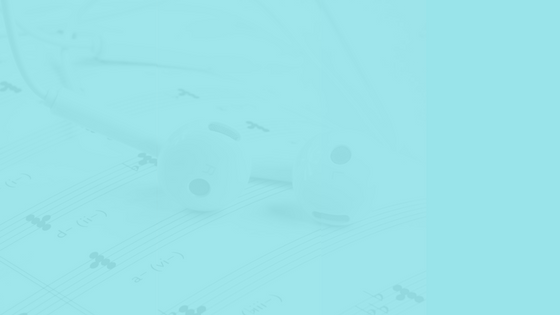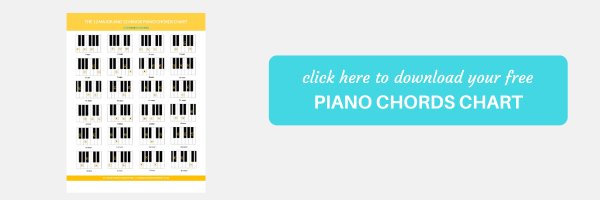THE 4 MUST-KNOW PIANO CHORDS FOR BEGINNERS
If you’re a beginner, I’m sure you’re excited to start playing the songs you love on the piano but you also might be asking, what piano chords should you start with?
Well, you’re in the right place.
In this post, I’ll reveal to you the four piano chords that every beginner pianist must know. You, my friend, will be amazed at how many songs you can play with just these four chords. When you know these piano chords, you can play almost any song under the sun.
Yeap. I’m not kidding. You’ll see. 😉
But first of all, what is a chord and how do we form it on the piano?
What is a chord?
In a nutshell, a chord is a bunch of notes or pitches put together and played simultaneously. There can be two or more notes that make up a chord.
Now, the most basic chord is known as a triad chord. It consists of the root, third, and fifth notes of its scale.
There are two types of chords that you should start with. They’re the major and minor chords.
Do you know that there are 12 major and 12 minor chords that can be formed on the piano?
Oh yeah! That looks like a lot of chords to remember right? But don’t you worry, I have 2 simple formulas to play all 12 major and 12 minor chords on the piano. Or better still, you can download all 12 major and 12 minor chords chart below!
Major chords often sound happy and positive while minor chords often sound sad and melancholic. Let’s look at them one by one.
Major Chord
So first, the major chord. Here I’m using C major chord as an example.
As I mentioned earlier, a basic triad chord consists of the root, third, and fifth notes of its scale.
For C major chord, the root note is C, the third note is E, and the fifth note is G. But how do we come up with this?
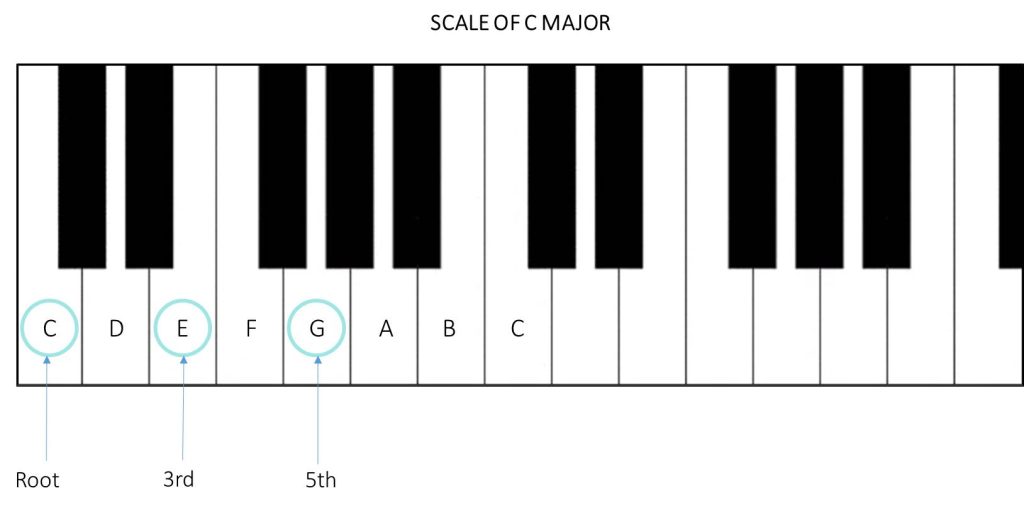
Now, to play any major chord, all you have to do is apply a simple formula of 5-4. So, what does that mean?
Let’s look at the C major chord again. It consists of the notes C, E, and G right?
To form this chord, all you have to do is to count 5 keys regardless of the color of the keys from the root note which is C, and land on E which is the third note. And then from there, we count 4 keys and land on G. And that’s your C major chord.
Below is the formula.
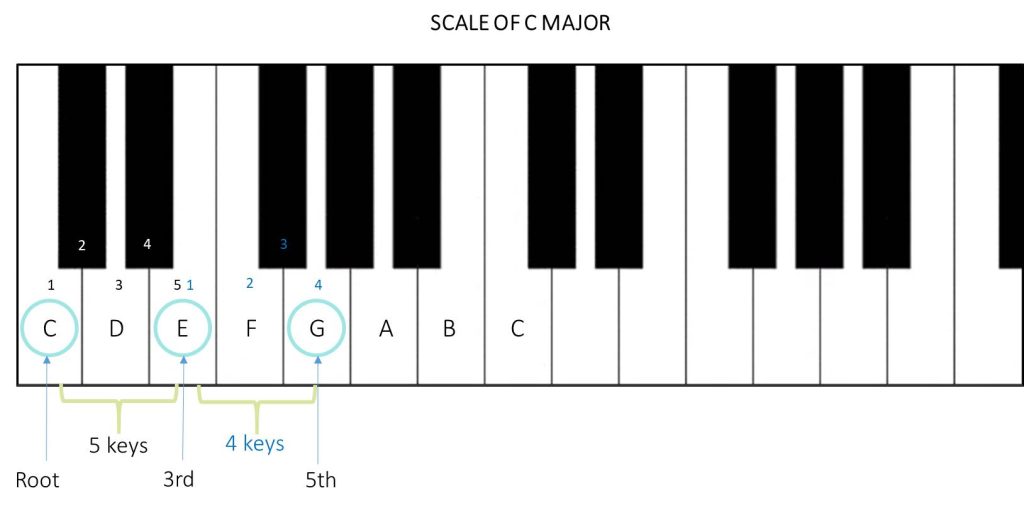
Minor Chord
Now let’s move on to the minor chord. Minor chords often sound sad or melancholic. Try it on the piano and see how you feel about it.
This is A minor chord. The root note is A, the third is C and the fifth note is E.
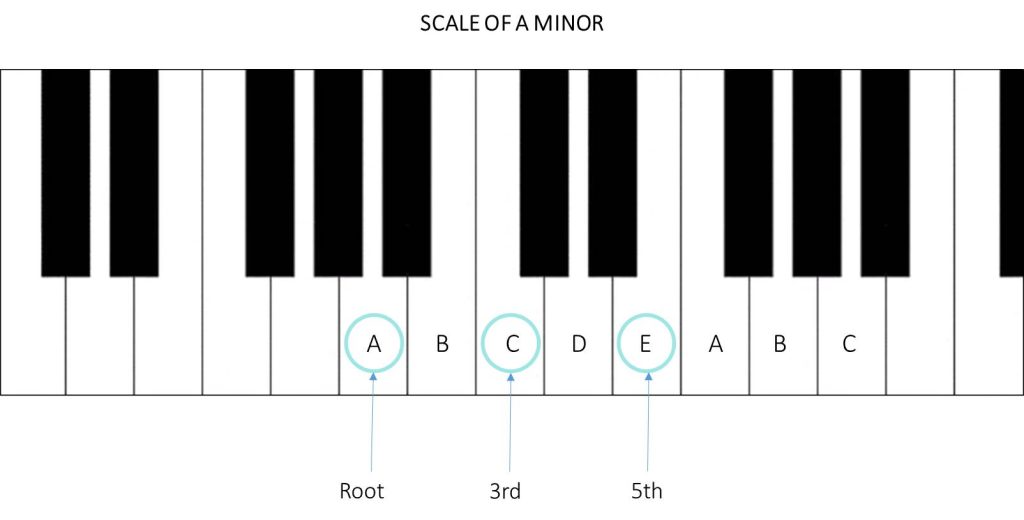
Similarly, there are 12 minor chords that can be formed on the piano. To play any minor chord on the piano, all you have to do is use the formula of 4-5.
Now using A minor as an example, you count 4 keys regardless of the color of the key from the root note A and land on C. From C, you count 5 keys regardless of the color of the key, and land on E.
And baaammm! That’s you A minor chord.
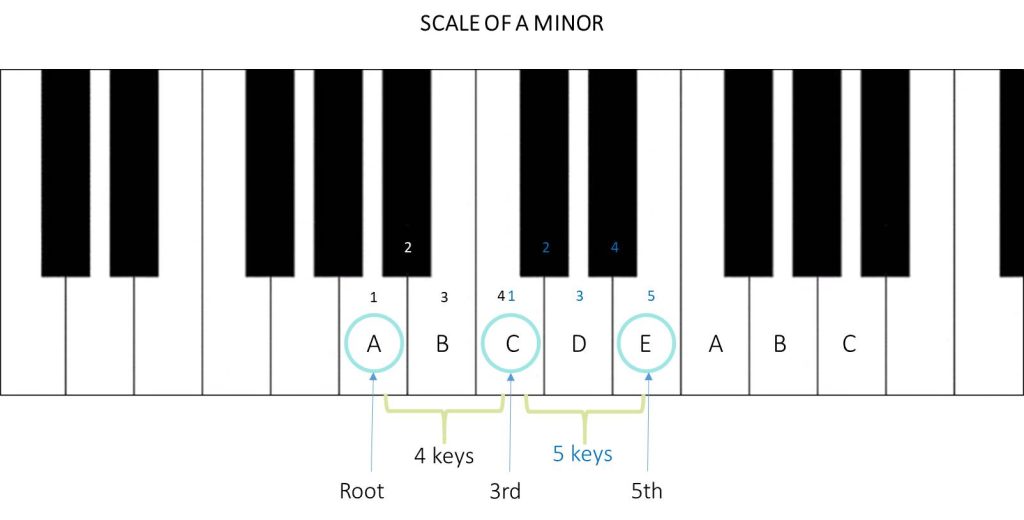
The 4 piano chords to start with if you’re a beginner
Let’s put things into action! I’m a strong believer that you get good at something when you’re doing the actual thing.
So, if you’re a beginner pianist, I strongly recommend that you start with just these 4 chords here and use them to play actual songs:
C major – G major – A minor – F major
Get yourself really familiar with them, play them accurately, and then learn to switch from one chord to another smoothly.
C major chord
The first chord that you’re gonna play is C major chord. As we’ve seen earlier on, the C major chord consists of the pitches C, E, and G.
These pitches are played simultaneously as one sound (block chord) or one pitch at a time as the broken chord. But I want you to start by playing the chord as a block chord first.
This is a C major chord.

How to play C major chord
On your right-hand side, play C major chord using the fingerings 1-3-5 as shown below. While on your left-hand side, play the bass note of C major chord which is C. Use your 5th finger to play this bass note.

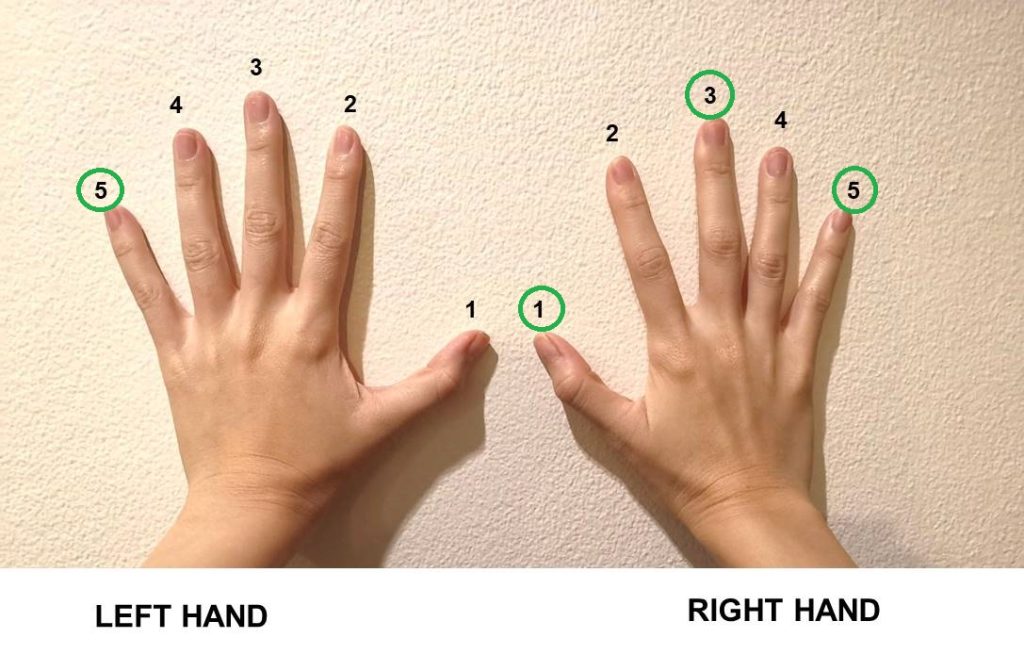
G major chord
The second piano chord that every beginner must not miss is the G major chord. Now, the G major chord is also a major chord. So it is the “happy” chord. 😀
Remember the major chord formula 5-4? Applying this formula will get you G major chord as shown below.
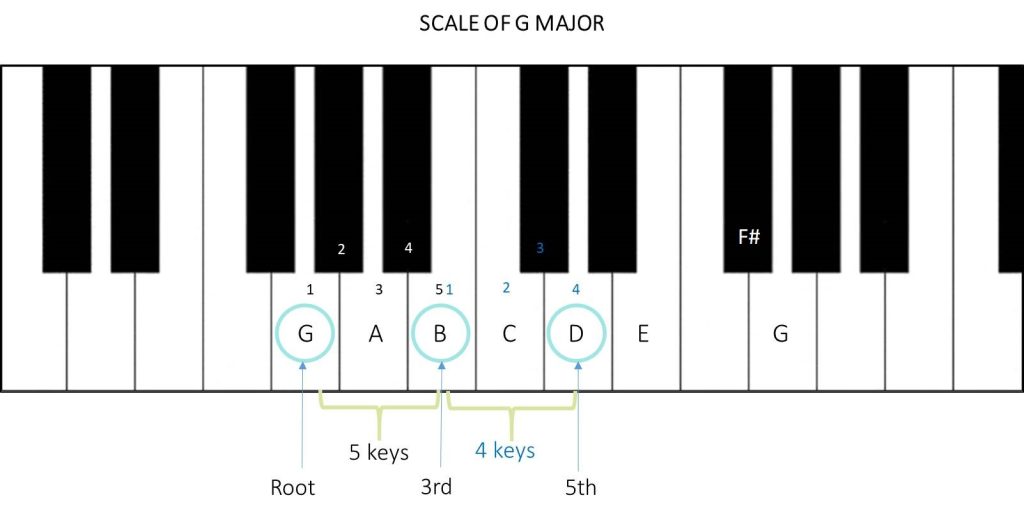
It also consists of the root, third, and fifth notes of its scale. The notes are G, B, and D.
How to play G major chord
Similarly, use the fingerings 1-3-5 to play G major chord. While on your left-hand side, play the bass note of G major chord which is G. Use your 5th finger to play this bass note.


A minor chord
The next piano chord that I want you to have in your repertoire is the A minor chord. This chord is a minor chord which means it is the “sad” chord. Try it out for yourself on the piano and see what you think.
Now, remember the formula for a minor chord is 4-5? Applying this formula will get you A minor chord as shown below.

The A minor chord consists of the root note A, the third note C, and the fifth note E of its scale.
How to play A minor chord
Play A minor chord with your right hand using the fingerings 1-3-5 and play the bass note of the chord, A with your left hand using your 5th finger as shown below.


F major chord
Here comes the last piano chord perfect for beginners like you. It’s the F major chord and it’s also a major chord. Applying the major chord formula 5-4, you’ll get F major chord consists of the notes F, A, and C.
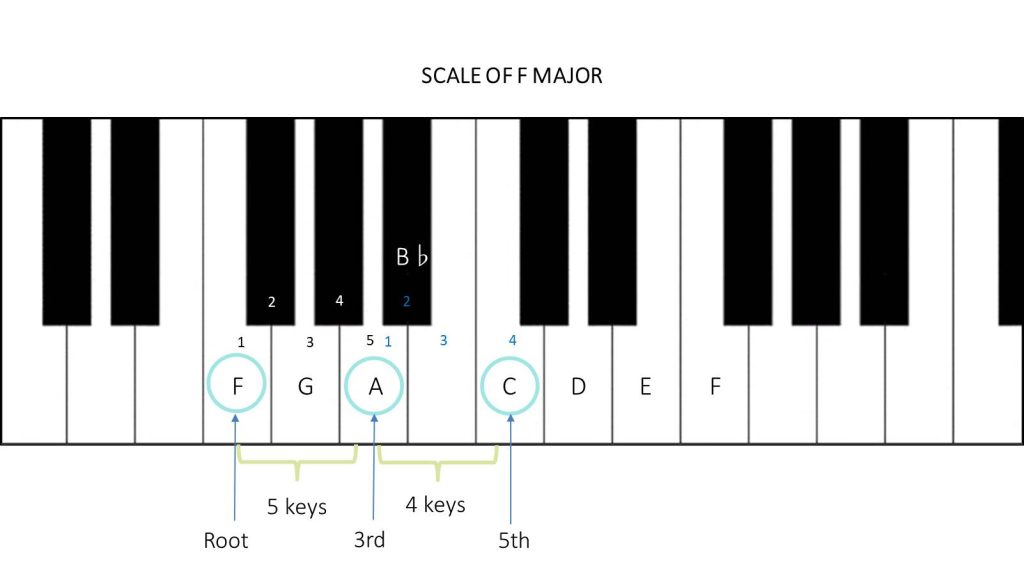
How to play F major chord
For F major chord, we’re also using the fingerings 1-3-5 on our right-hand side, and on our left-hand side, we use our 5th finger to play the bass note of this chord, F.


By the way, if you haven’t gotten your free copy of the 12 major and 12 minor chords chart, be sure to download it in the link below.
Chords progression
These four piano chords are best for you if you’re a beginner and just starting out. Remember, the point here is not to be able to play all chords at one time but rather take it one chord at a time and perfect it as you go.
These 4 chords that I recommend are considered the “easy chords” and they’re used in many pop songs you know. These piano chords are arranged in a series of chords sequence or chords progression by music composers and used in songs.
Well, let’s talk about chord progression for a minute.
You may have heard or have not heard of chord progression before.
Chords progression is just a fancy way to describe the chords sequence used in a song.
When we combine the chords C major chord, G major chord, A minor chord, and F major chord, we can form a chord progression C major – G major – A minor – F major. This progression is also described as I- V- vi- IV in a musical term. This is just ONE of the many chord progressions used in songs.
If you want to learn more about chords progressions and how they come about, you can check out my post on this topic called The One Chords Progression You Must Know to Play Tonnes of Songs (Beginners).
Why is chord progression important in music?
When we know the chord progression of a song, it makes it easier to learn a song because a chords progression is usually repeated throughout a song.
Check out the chords progression of the song, Hello by Adele in the chords sheet below:
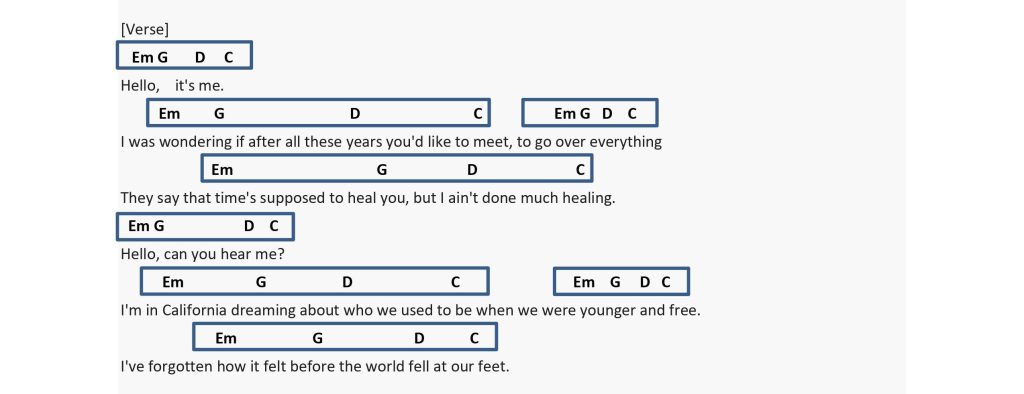
You’ll notice that the same chords progression E minor – G major – D major – C major repeats throughout the verse.
When you can play just these four chords, you can just repeat these chords for the whole verse! Yeay!!! Easy isn’t it? 😀
Chords progression is also important because it makes it easy to transpose from one key to another.
For example, if you’re playing a song as an accompaniment to a singer who sings in the key of C major and feels that the key is too high for her, you can easily transpose the whole song to a lower key to suit her voice range.
You may transpose the song to G major key perhaps.
For example, using the chords progression table below to transpose the key of the song from C major to G major for the progression I – vi – IV – V, you’ll get the chords G major – E minor – C major – D major.

Chords progression is also important for musicians playing in a group to know immediately what chords other musicians are talking about.
For example, they know what chords are involved when someone says, “Key of G major, I -vi – IV – V”. All instrument players involved can understand this and play in the same key easily and quickly.
What songs can you play with these piano chords
Now that you know these 4 important piano chords for beginners and understand how chord progression helps you to learn a song faster, let’s put them into action!
Here’s a list of some of the songs that you can play with the chords you’ve just learned.
- Let It Be by the Beatles
- Say You Won’t Let Go by James Arthur
- Take Me Home, Country Roads by John Denver
- You’re Beautiful by James Blunt
- Can’t Help Falling in Love by Elvis Presley
- She Will Be Loved by Maroon 5
- Unchained Melody by Elvis Presley
- Perfect by Ed Sheeran
- Can You Feel the Love Tonight by Elton John
- Someone You Loved by Lewis Capaldi
- Living On A Jet Plane by John Denver
You can find the chords sheet for these songs or any songs you want to play at ultimateguitar.com.
How to use these piano chords to play songs
The next question you may be asking is, “How do I use these chords to play songs on the piano?”.
In this segment, I’ll show you exactly how to use the piano chords C major, G major, A minor, and F major to play songs. You can watch the video here or read on.
Let’s take a look at this chords sheet here. I’ve put together a medley of 3 songs as an example.
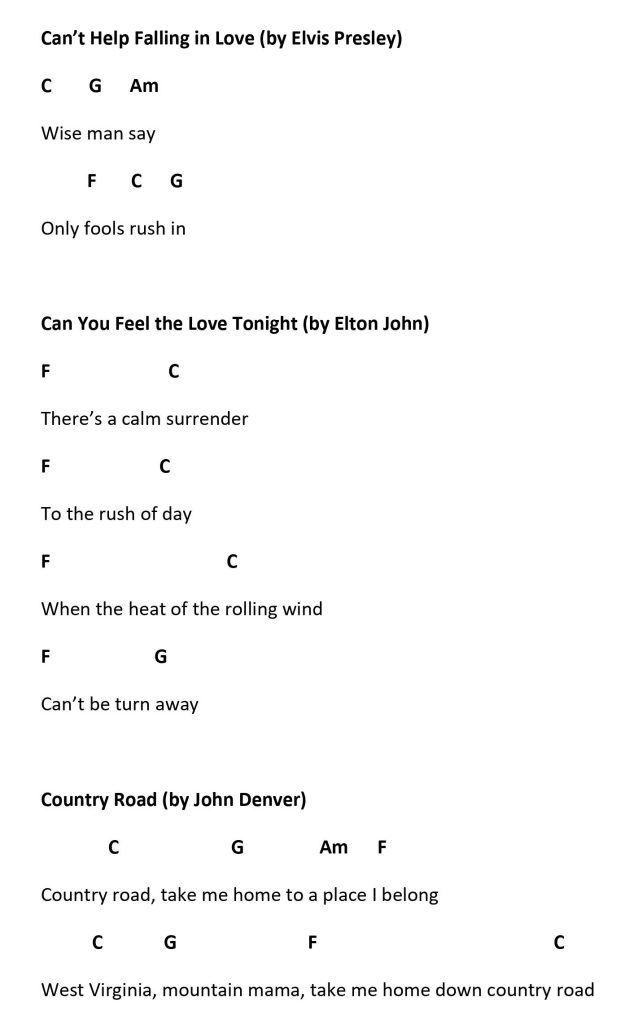
First, I want you to get used to how chords are represented on a chord sheet. Major chords are represented by capital letters while minor chords are represented by capital letters with a small “m” next to them.
This is something you may want to get used to in the world of “chords”. 😀
Now, see that these chords are written above the lyrics. For this part, the chord C is written above the word “Wise”. This means you’re going to play C major chord when you sing the word “Wise” simultaneously.
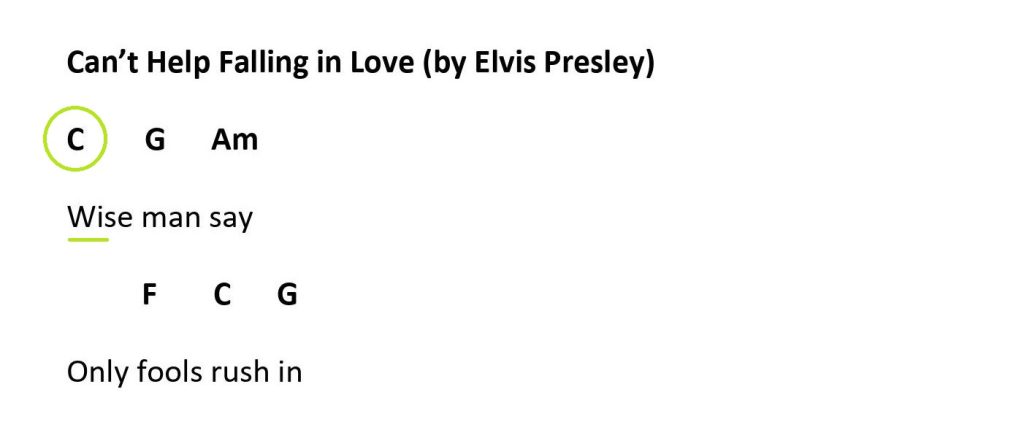
For the next chord, we play G major chord when we sing the word “man” simultaneously, and so on.
When we play the chord, we use our right hand while our left hand plays the bass note of the chord.
For example for C major chord, the bass note is C, G major is G, A minor is A, and F major is F.
Play the chord and the bass note together and count the beats before switching to the next chord.
You can also play the chord on each of the beats.
Conclusion
So, what have we learned today?
First, we’ve looked at the four essential piano chords for beginners like you and found out how they’re formed on the piano. Second, we talked about the chord progressions and how they’re used in songs and finally, we learned how to use these piano chords to play actual songs.
The best and fastest way to learn the piano is to play real songs, songs that you love! So, off you go and try them out on the piano now!
Do let me know in the comment box below how you go with it.
If you feel like this post is helpful, it’ll mean so much to me if you could share it with other beginners who also need help with this topic. Thank you!

